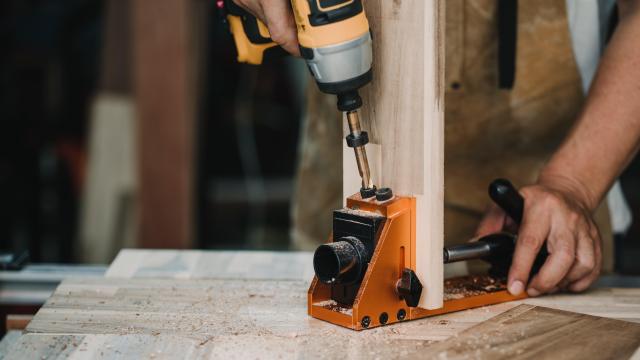The challenge of hiding hardware when attaching two pieces of wood can be daunting if you’re new to carpentry. If you’re not practiced in making dovetail joints and you don’t own a dado blade — or even know what those things are — making sturdy wood joints that also look nice is difficult. Enter, the pocket hole jig — a tool made for drilling screws at an angle. It is a simpler and cheaper solution for projects that have a “back” side that doesn’t get seen as much, like the wall side of a frame or the underside of a bench. Better yet, even beginners can use it.
A pocket hole jig works by keeping your drill bit at a shallow angle to the surface you’re drilling into without allowing the bit to slip or move. This lets you drill holes to drive a screw from one piece of wood into an adjoining piece without showing on the opposite surface — and without the head of the screw sticking out on the side you’re driving it into. You can use them to hide screws on the back and under sides of furniture and as a quick way to make a corner that’s stronger than one secured by nails or staples.
(The downside to pocket holes is that they’re not as strong as other types of joints that involve trimming the board to overlap, like a lap joint or a mortise and tenon.)
What you need to operate a pocket hole jig
The tools you’ll need to operate a pocket hole jig are:
- A drill
- An extra-long drill bit (with a stopper the right size for the screws you’ll be using)
- Some clamps
- Your jig
- Optional: dowels, a flush cut saw, tape measure, and wood glue
By the way, you can save on your next home DIY with one of our eBay discount codes.
You can also get an adaptor kit for regular drill bits if you’ve already got a bit that works. Some jigs come with their own stopper bit, so that’s not always required. There are different types of jigs. Some have clamps built in, and some can be clamped in place on your project. If you want to fill your holes after driving your screws, you will also need some dowels. You can get pre-cut pocket hole dowels, but you can also insert a regular dowel peg and use a flush cut saw to strim them to fit.
Depending on what you’re building, you will also need a tape measure and some wood glue to strengthen your joint.
How to use a pocket hole jig
To use the jig, choose where you would like to join your two pieces and mark where the screws will go on the board. Then, position your jig on the board, setting the depth of the jig so your screw will be long enough to capture both of your pieces of wood without breaking the opposite surface. If you’re not sure of the depth, do a test on a piece of scrap wood.
Once you’ve measured where your screws will go, line up the holes in the jig with your marks, clamp the jig firmly in place, and drill your hole. Then, you can line up your joint, clamp your pieces together, and drive your screws. Using clamps to keep your joint square and flush is important because driving a screw at an angle will cause the wood to shift. You can prevent this by clamping your two boards together to a flat surface. Using an angle clamp is the best way to get a square, secure joint.

Leave a Reply
You must be logged in to post a comment.